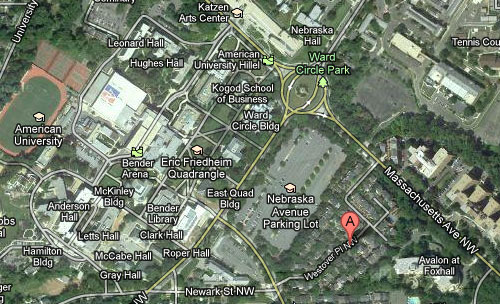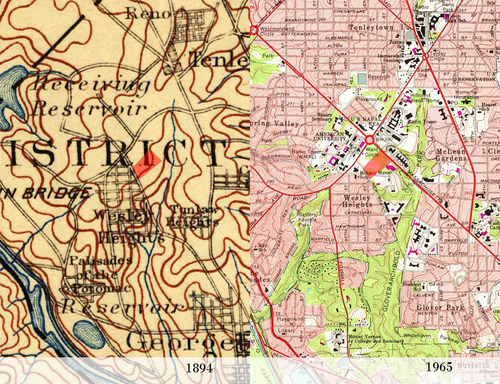An opposition hotbed near AU was once itself opposed
The strongest criticism to American University’s East Campus project has come from some neighbors in the adjacent Westover Place private community. Their case against the plan, however, is eroded by a development fight 36 years ago, where their own homes were the development threatening to spoil Northwest’s character.
Just as some residents are fighting the potential of AU’s campus expansion, so did an earlier generation fight the development of the property that abuts a five-acre parking lot AU wants to turn into a leafy complex of low-rise residential buildings.
A substantial amount of opposition has arisen in Westover Place, a gated complex of rowhouses between Massachusetts Avenue and Foxhall Road New Mexico Avenue. They have been the most vocal at ANC 3D meetings, insisted that AU build its buildings next to other people’s homes, and gathered there for this summer’s traffic protest.
But in 1977, it was the threat of Westover Place that was vexing locals. According to a September 25th, 1977 Washington Post article:
And to the north of this, adjacent to the 5-acre university parking lot, Kettler Brothers Inc., the giant development company that built Montgomery Village, has already cleared more than eight acres where 149 town houses will be constructed. Houses in this development, Westover Place, will sell from about $135,000.
In the article, entitled “Bulldozers at the Estates,” Phil McCombs reports on arguments and characters not unlike the current fights over American University’s expansion and other developments in the area. Just as before, opponents are appealing to a right of first arrival, but the article lays bare the hypocrisy in living in a development while fighting a development because it will have the same effects your house did. The rowhouses of Westover Place and similar developments paved over Northwest’s last open spaces that seemed so essential to the “rural” character of piedmont Washington.
Similar to the opposition to the
1960 Tenley Library and the 1941 Sears Roebuck, an enormous to-do was made over the development and yet both became established elements of the community. At that time, however, the changes seemed signified the end of something unique. McCombs quotes the ANC3 Commissioner Polly Shackelton bemoaning the change:
“Here you have these fine established residential neighborhoods, which will be impacted with increased density and traffic and all kinds of things that really could be very damaging,” she said. “I think in a way it’s too bad we don’t have a comprehensive plan.”
She said that development of the Rockefeller estate, for example, “will be devastating because Foxhall Road is already crowded. With 100 new houses there, I don’t know how we’ll deal with it.”
The problematic idea here is “establishment”: that because a neighborhood has reached any level of development at all, it should be maintained as it is. Are the current residents who now enjoy this property more justified than their neighbors who lived there in 1977, or estate owners who lived there in 1917?
No, these developments were part of the gradual urbanization of rural estates with density that is more appropriate to a close-in area. In 1977, it was the end of estates, and now it is a shift away from suburban design. Planning should manage change, but we cannot presume to think that any section of a city is in its final state. This flux, and its resistance are the same as today as they were a generation ago.
The objections seem as new (and as stale) as ones thrown up on the Tenleytown listerv yesterday. Just as opponents of Douglas Development’s proposal for the former Babe’s Billiards site have argued, in 1977 “Area residents said they are concerned that students from the nearby university will team up in the apartment buildings — creating what one person called ‘rabbit warrens.’ There is also concern that parking space will be insufficient, or that residents of new developments will park in the streets rather than pay to park in areas provided by the developers.”
But the city and its infrastructure have been able to adapt to the new houses and the new apartments. The Metro arrived at Tenleytown and Friendship Heights. Both of those neighborhoods have survived significant growth, and quality of life and environment has improved. Friendship Heights, in particular, remains extremely popular as a place to raise a family, even has it has grown more popular as a retail destination and apartment community.
Long-term residents recall the fight of the development of the Glover estate as quite heated, yet the predicted cataclysms never came to pass. Residents of newer developments have integrated into the community, enough to fight changes, at least. Why should we expect any of the dire predictions about AU’s expansion to come to fruition?
Cross-posted at цarьchitect. A version of this post appeared in the November 15th, 2011 issue of the Northwest Current.



